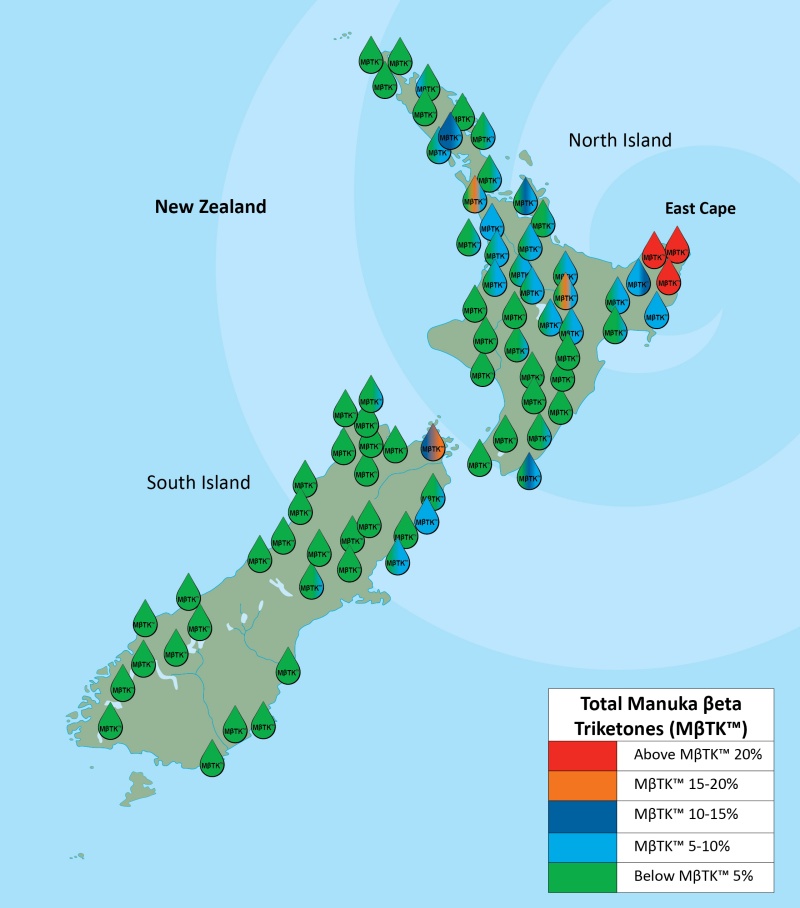When navigating the market for mānuka oil, distinguishing between superior and lower-quality products can pose a challenge. Understanding the grading systems employed in mānuka oil production is a valuable tool for consumers, empowering them to make informed decisions and secure the highest quality of mānuka oil available.
What Is Mānuka Oil?
Mānuka essential oil is a potent oil known for its antimicrobial, antibacterial, anti-fungal, anti-inflammatory, and antiviral properties. It is derived from the leaves and twigs of the mānuka tree (scientifically known as Leptospermum scoparium), which is native to New Zealand.
The mānuka plant exhibits remarkable resilience, flourishing across diverse ecosystems in New Zealand, ranging from lowland to sub-alpine regions. It is the same plant that serves as the region’s primary source of mānuka honey.
Learn more about mānuka oil vs mānuka honey here.
What Is MßTK™?
The mānuka grading system for mānuka essential oil holds significant importance in evaluating the purity and potency of the oil.
In New Zealand, a grading system for β-triketones (βeta-triketones) found in mānuka oil has been established, known as MßTK™. This system quantifies the concentrations of naturally present triketones in mānuka oil through percentages.
In addition, it provides assurance of both mānuka oil quality and source.
MβTK™ Grading System
|
MβTK™ Grading |
Mānuka β-triketone Content |
| 5+ | ≥5% |
| 10+ | ≥10% |
| 20+ | ≥20% |
| 25+ | ≥25% |
| 30+ | ≥30% |
An average strength oil typically contains 20% triketones, denoted as MßTK™ 20+.
Employing the MßTK™ quality mark, the mānuka oil grading system encompasses grades 5+, 10+, 25+, and 30+.
For example, a grade of 30+ denotes that the oil embodies no less than 30% beta triketones, indicating superior quality and potency.
In general, the higher the MβTK™, the higher its triketone content.
The Importance of Triketones
A triketone is a naturally occurring organic chemical compound found in the environment. Known for their powerful antimicrobial properties, triketones are highly effective in fighting against harmful bacteria, fungi, and inflammation.
East Cape mānuka oil is especially rich in ß-triketones (ßeta-triketones). Mānuka oil from various locations in New Zealand can be divided into three main chemo-type groups according to the ratio of monoterpenes/ sesquiterpenes/ beta-triketones.
East Cape Mānuka ßeta Triketones: Why It’s Superior

Mānuka Oil ßeta Triketones (MβTK™) are found at exceedingly high levels, sometimes above 30%, in mānuka oil sourced from the East Cape of New Zealand–making it particularly effective for combating microbes and promoting health.
When compared to other types of mānuka oil and oils like Kanuka and Tea Tree Oil, East Cape mānuka oil exhibits significantly higher levels of beta-triketones, including leptospermone, isoleptospermone, flavesone, and grandiflorone. These beta-triketones have been confirmed through GC-FID/MS analysis.
The Importance of Grading in Mānuka Oil
Grading is essential in maintaining consistency and authenticity in mānuka oil products, ensuring consumers obtain the intended therapeutic benefits. It distinguishes between different oil grades, enabling consumers to make well-informed purchase decisions.
The droplet graphic displayed on a mānuka oil product indicates the minimum concentration of MßTK % by GC-FID peak area.
Why Buy MßTK™ Certified Mānuka Oil
As a natural product, similar to mānuka honey, nānuka oil exhibits variations in antimicrobial potency. The MßTK™ grading system serves as an effective means of conveying the strength and quality of the mānuka oil, enabling consumers to choose the grade of oil that best fits their requirements.
A higher MßTK™ rating indicates a lower concentration required to eliminate bacteria effectively.
Geographic Variations
Variations in Total Triketone Content Across New Zealand’s Geography

Source: mānuka Beta Oil β-Triketones MβTK™ :: MβTK™ Geographic Variations (mbtk.org.nz)
Mānuka oil from the East Cape region of New Zealand is very high in β-triketones (βeta-triketones). The map above illustrates the geographic variations in total triketone content for mānuka oil across New Zealand, emphasising the localised nature of this area within the country.
The mānuka tree is widespread across New Zealand, but the concentration of MβTK™ content varies considerably depending on the harvesting location.
There are notable differences in the β-triketone content of mānuka oil due to the geographic source within New Zealand. Research by Douglas et al. (2004) demonstrates that the total MβTK™ levels in mānuka oil can range from below 1% to over 30% throughout New Zealand, with the North Island’s East Cape region exhibiting significantly higher levels than other areas in the country. Additionally, seasonal variations are observed.
These geographic differences in mānuka oil are attributed to genetic variations within the Leptospermum scoparium species. Seeds collected from various locations and grown in one location retained their fundamental chemotype profile.

